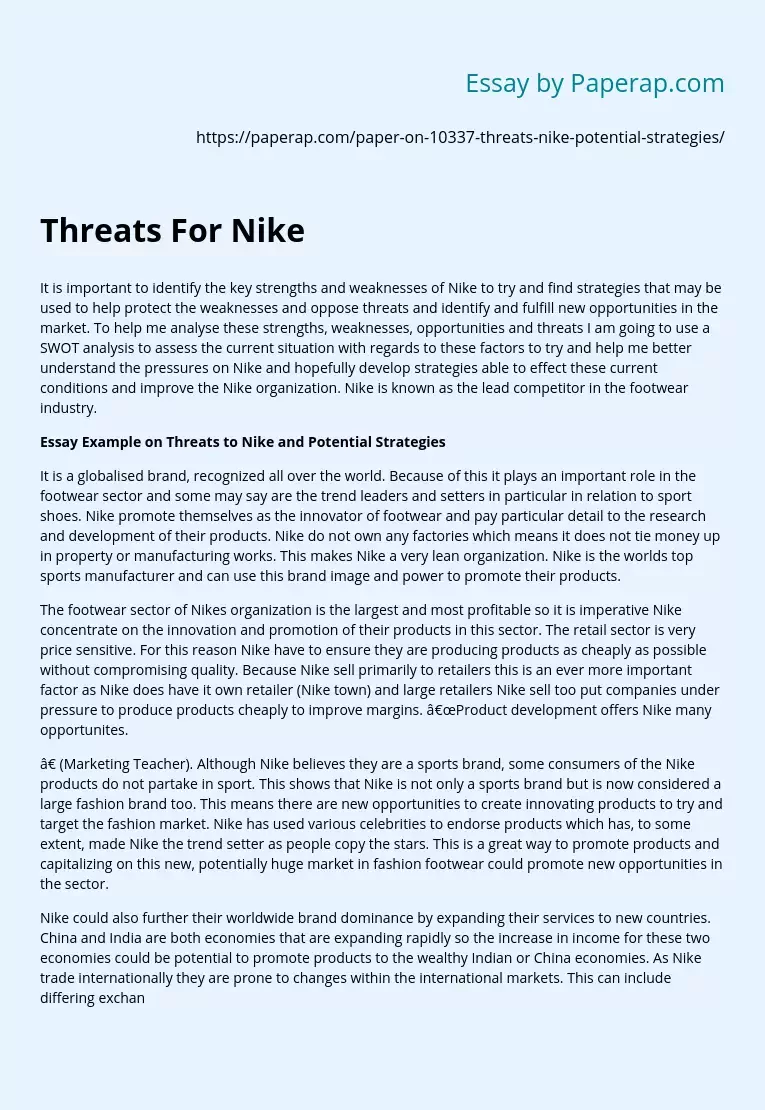Threats For Nike
It is important to identify the key strengths and weaknesses of Nike to try and find strategies that may be used to help protect the weaknesses and oppose threats and identify and fulfill new opportunities in the market. To help me analyse these strengths, weaknesses, opportunities and threats I am going to use a SWOT analysis to assess the current situation with regards to these factors to try and help me better understand the pressures on Nike and hopefully develop strategies able to effect these current conditions and improve the Nike organization.
Nike is known as the lead competitor in the footwear industry.
Essay Example on Threats to Nike and Potential Strategies
It is a globalised brand, recognized all over the world. Because of this it plays an important role in the footwear sector and some may say are the trend leaders and setters in particular in relation to sport shoes. Nike promote themselves as the innovator of footwear and pay particular detail to the research and development of their products.
Nike do not own any factories which means it does not tie money up in property or manufacturing works. This makes Nike a very lean organization. Nike is the worlds top sports manufacturer and can use this brand image and power to promote their products.
The footwear sector of Nikes organization is the largest and most profitable so it is imperative Nike concentrate on the innovation and promotion of their products in this sector. The retail sector is very price sensitive.
For this reason Nike have to ensure they are producing products as cheaply as possible without compromising quality. Because Nike sell primarily to retailers this is an ever more important factor as Nike does have it own retailer (Nike town) and large retailers Nike sell too put companies under pressure to produce products cheaply to improve margins. “Product development offers Nike many opportunites.
” (Marketing Teacher). Although Nike believes they are a sports brand, some consumers of the Nike products do not partake in sport. This shows that Nike is not only a sports brand but is now considered a large fashion brand too. This means there are new opportunities to create innovating products to try and target the fashion market. Nike has used various celebrities to endorse products which has, to some extent, made Nike the trend setter as people copy the stars. This is a great way to promote products and capitalizing on this new, potentially huge market in fashion footwear could promote new opportunities in the sector.
Nike could also further their worldwide brand dominance by expanding their services to new countries. China and India are both economies that are expanding rapidly so the increase in income for these two economies could be potential to promote products to the wealthy Indian or China economies. As Nike trade internationally they are prone to changes within the international markets. This can include differing exchange rates so costs and margins are not as stable as they could be. This means Nike has to assess its markets and products especially regarding price, regularly to stay competitive.
Most of Nikes products are manufactured abroad to make them cheaper, however, many other companies including Nike’s top competitors have done the same in order to compete with Nike’s cheap production costs. This has made the footwear market very price sensitive and so price competitiveness is now more important than ever before. In the following diagram it shows the fall of the average price of footwear in the UK from 2002-07. This demonstrates the importance of lowering costs as Nike no longer have a sufficient competitive advantage in this sense.
Threats For Nike. (2019, Nov 27). Retrieved from https://paperap.com/paper-on-10337-threats-nike-potential-strategies/

